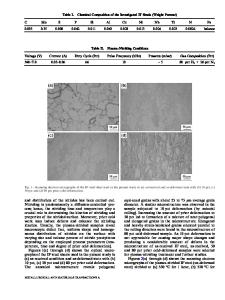Effect of Heat Input Conditions on Microstructure and Mechanical Properties of Friction-Stir-Welded Pure Copper
- PDF / 1,613,973 Bytes
- 12 Pages / 593.972 x 792 pts Page_size
- 102 Downloads / 370 Views
INTRODUCTION
COPPER and its alloys have a wide range of applications due to their excellent properties, such as good ductility, corrosion resistance, electric conductivity, and thermal conductivity.[1] The welding of pure copper is extensively used in industrial production, such as in the nuclear industry and in vacuum devices.[2,3] Conventional fusion welding and braze welding have some obvious limitations. For fusion welding, a high heat input is required due to the good thermal conductibility of copper, resulting in remarkable grain coarsening with a wide heat-affected zone (HAZ) and a significant distortion with high residual stress. On the other hand, the strength of brazed copper joints is significantly lower than that of the fusion welded joints.[1] Friction stir welding (FSW), invented by The Welding Institute of the United Kingdom in 1991, is an energyefficient, environmentally friendly, and versatile joining technique.[4] The application of FSW has been reported in many industrial sectors, such as the production of ship panels, the frames of high speed railway, and the P. XUE, Postgraduate, B.L. XIAO and Z.Y. MA, Professors, are with the Shenyang National Laboratory for Materials Science, Institute of Metal Research, Chinese Academy of Sciences, Shenyang 110016, P.R. China. Contact e-mail: [email protected] G.M. XIE, Lecturer, is with State Key Laboratory of Rolling and Automation, Northeastern University, Shengyang 110004, P.R. China. L. GENG, Professor, is with the School of Materials Science and Engineering, Harbin Institute of Technology, Harbin 150001, P.R. China. Manuscript submitted September 22, 2009. Article published online June 9, 2010 2010—VOLUME 41A, AUGUST 2010
suspension arms of cars.[5] Extensive studies on the FSW of aluminum and its alloys have been reported, but limited research is available for copper.[6–13] As a solidstate welding process, FSW is performed at a temperature lower than the melting point of the materials. FSW involves a severe plastic deformation (SPD) process, and dynamic recrystallization (DRX) occurs in the stir zone (SZ) during the FSW process.[14] Therefore, the heat input during FSW of copper is much lower than that of conventional fusion welding methods, and high-quality copper joints with less distortion and higher strength can be obtained via FSW. Recently, the copper containment canisters for nuclear waste have been manufactured via FSW by the Swedish Nuclear Fuel and Waste Management Co.[6,7] Furthermore, Okamoto et al.[8] reported that the backing plates of copper alloy, used for the sputtering equipments, have been successfully welded by FSW. Although the heat input for FSW is significantly lower than that for fusion welding, previous investigations on FSW of pure copper indicated that defect-free pure copper welds were achieved only at a lower traverse speed or higher rotation rate, i.e., higher heat input conditions.[8–10] For example, Okamoto et al.[8] reported that 6-mm-thick copper plate was successfully welded at a rotation rate of 1300 rpm and a traverse speed
Data Loading...











